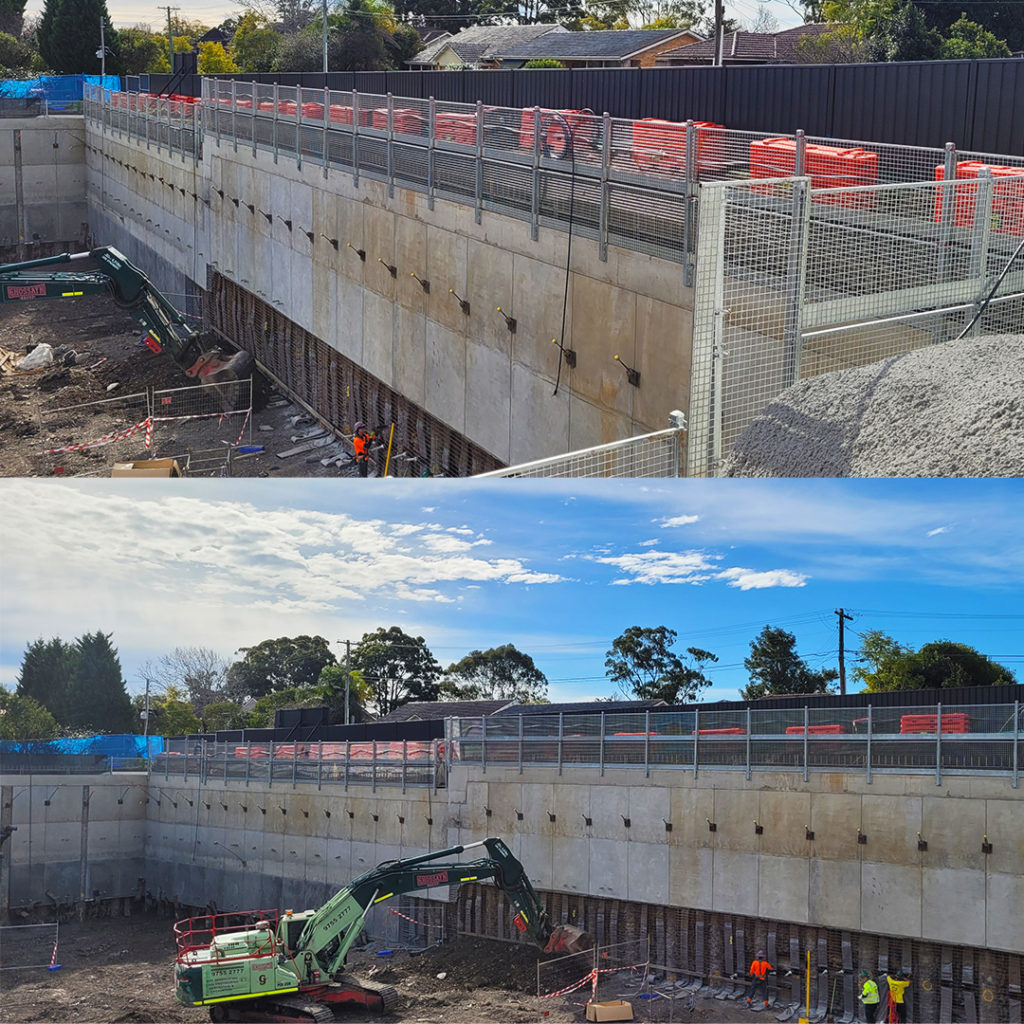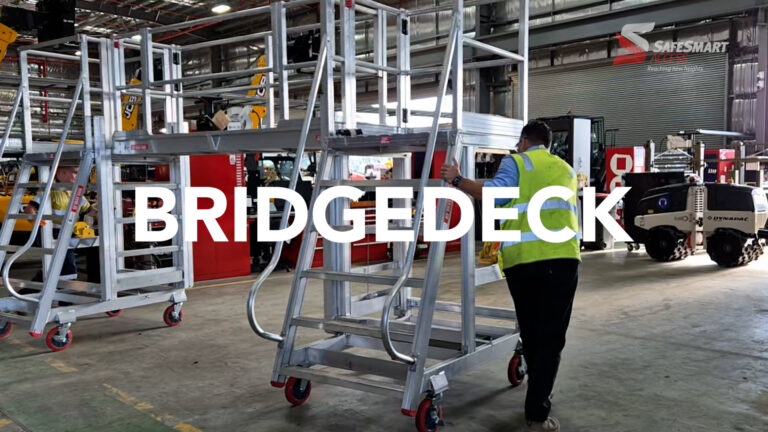Capping beams are an integral part of construction, used across many industries from rail infrastructure to basement construction.
They are typically used in deep foundation construction. This is where the ground is not strong enough to support the weight of the structure without additional support.
When doing deep foundation construction, sites are based around voids or excavations. These present major fall risks for workers and require stringent safety measures.
SafeSmart has a variety of safety solutions when it comes to working at height, and this includes capping beam edge protection.
The guide below explains what capping beams are, what different types of capping beams are used, and why they are an important part of deep foundation construction projects.

Understanding capping beams
To understand capping beams, you have to first understand pile foundations.
These are deep foundations made of long, slender columns of reinforced concrete. To be considered pile foundations:
- They need to be at least three times deeper than their width
- Transfer the above ground structural load through weak subsoils or water onto more solid rock or earth below it
- Can be driven or bored through tens of metres below ground if necessary.
To link piles together, a reinforced concrete cap is used. You can link these pile caps with capping beams, helping protect the piles from erosion and other kinds of damage.
Capping beams are structural elements that are usually made out of steel and concrete. They sit along the top of the piling to strengthen it all. They tie all the piling together, create foundations for the slabs, and help to strengthen the structure against shear and tension loads.
They are more commonly used in deep foundation construction where the ground is not strong enough to support the weight of the structure without additional support.
To create a capping beam, a minimum of three capped piles are required. There are a few ways capping beams can be constructed:
- In-situ using a mould with plywood
- Steel where most of the strength comes from
Steel reinforcement bars are specifically engineered to fit over the top of the piling cages. Concrete is sprayed or poured onto it once the reinforcement is complete. When the concrete dries, the formwork can be removed.
Capping beams should not be touching the ground. This is typically done with polystyrene or other kinds of compressive materials acting as a barrier. This allows upward ground movement without damaging the beams.
Why are they important in construction?
Capping beams serve a variety of very important purposes in construction. They ensure the safety and stability of structures by transferring loads and preventing damage from external factors.
They are essential in ensuring proper weight distribution. One of the capping beams main functions is shifting the load from one column or pile to another. This helps prevent the piles from being overloaded and failing.
They significantly reduce the risk of differential settlement. Differential settlement happens when one part of a structure’s foundation settles more or faster than the other.
To maintain a proper foundation, they work towards distributing load-bearing walls or close-centred columns to a line of piles.
They also help to keep piles or columns in place during the excavation process. When constructing things like basements with preinstalled piles, excavating puts pressure and stress on the adjacent pile foundations. It has been known to cause severe damage with the possibility of collapse.
Capping beams stabilise and prevent lateral displacement of the piles during construction. This is particularly important when it comes to earthquake and wind prevention. However, this could also just be soil shifting down and forward into an excavated area.
Capping beams also move vertical structural loads from the structures to the piles, columns, or any other retaining structure. Also known as gravity loads, capping beams work to distribute the vertical loads equally to the piles.

Dangers Associated with Capping Beams & Excavations
There are a significant amount of safety risks when working with capping beams, especially when working with them alongside excavations:
- Workers are more likely to fall: If not properly secured or without proper edge protection, workers can lose their balance and fall to serious injury or death.
- Objects can fall from above: This could be many things like tools, materials, debris, or even other workers, heightening the risk of injury to workers both above and below.
- Entrapment becomes an issue: Especially in confined spaces, workers can get trapped between equipment or other structures.
- In worst cases, electrocution can be an issue: This is in case of loose electrical wires workers could come in contact with.
Our Solution: Temporary Works Edge Protection
SafeSmart offers a comprehensive solution for capping beam edge protection. Not only to protect workers from the dangers posed by working with heights, but also any hazards working inside the excavated areas.
When debris, tools, and other construction materials are often left lying around, injuries and falls are even more likely than in other worksites. Falls from height are the leading cause for death or injury for construction workers in Australia.
Usual safety protection for capping beams includes warning signs, flimsy protective netting around the edge of the excavation area, and toe boards that do nothing to protect from falls or debris falling from height.
We understand the risks surrounding capping beam and excavation construction, which is why we specialise in heavy-duty and complete safety solutions for construction sites.
The I-Klamp Edge Protection system is non-intrusive and effortless. Compared to other pesky edge protection systems that require drilling into hard concrete, our I-Klamp system has a drill-free attachment that allows for easy installation and removal. This makes it ideal for the temporary sites where construction is not expected to take too long. Used in conjunction with our temporary non-drill handrail posts, King Klampz railing system, or our temporary drill-down handrails, it offers robust edge protection.
Flimsy edge protection is the downfall of many worksites. Our AdaptaPanel premium and AdaptaPanel FC premium modular edge protection fencing systems offer far more robust protection than others on the market. Ideal for capping beams, these have heavy-duty framed panels for longevity in harsh conditions and safety latches to prevent panels from lifting off.
While our AdaptaPanel premium design is mainly used for longer-term, semi-permanent projects, the AdaptaPanel FC modular system is great for temporary projects and easy transport. The AdaptaPanel FC modular system includes a debris netting support as an extra safety feature.
When capping beam projects require scaffolding solutions, we supply safety nettings as an added level of protection, especially from falling debris in excavations. Our Triple layer debris netting provides far more protection than most other single or double-scaffold netting solutions, designed for direct attachment to constructed buildings or scaffolding.
Solving Capping Beam Hazards
When it comes to deep foundation excavation, capping beams are an essential cog in the process. They not only ensure safety and stability of pile foundations, but actively protect them from damage and erosion. As a temporary works and edge protection solutions company, we work hard to ensure the safety of every worksite. Safety is always in the forefront of our minds and is reflected throughout our work platforms, edge protection, and stairs ranges. As the construction industry develops and adapts, safety solutions must adapt alongside.
For More Information
If you are looking for easy safety solutions for your worksite, professional advice is always recommended. Companies looking for the best temporary access solutions need look no further than SafeSmart Access. Get in touch today!






